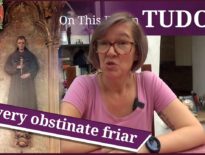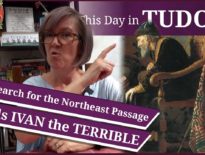On this day in Tudor history, 11th May 1560, royal physician Dr Thomas Wendy, died at his home, the manor of Haslingfield, in Cambridgeshire.
He attended three Tudor monarchs at their death and had a long and loyal service as a royal physician, but what interests Claire, in particular, is his role in saving Queen Catherine Parr, Henry VIII's sixth wife, from a plot by Catholic conservatives in 1546.
Find out more Dr Thomas Wendy, his life, career, and the plot in today's talk.
Also on this day in Tudor history, 11th May 1537, Blessed John Rochester and Blessed James Walworth, two Carthusian monks from the London Charterhouse, met their ends in York after being condemned for treason. Find out more about them and the other Carthusian martyrs in last year’s video:
And on this day in 1536, in the fall of Anne Boleyn, the Grand Jury of Kent met to rule on the alleged offences committed by Queen Anne Boleyn and her alleged lovers in the county. In my video on that day, I considered the dates, places and crimes cited in the indictments, and whether they made any sense at all.
Also on this day in history:
- 1509 – Henry VII was laid to rest next to his wife, Elizabeth of York, in Westminster Abbey.
- 1532 – Henry VIII accused the clergy of being “scarce our subjects”, and attacked their oath to the Pope.
- 1560 – Burial of John Falconer, physician and botanist, at St Stephen's Church, Coleman Street, London. Falconer. He is known as the first English person to have owned a herbarium.
- 1598 – Death of Edward Drew, lawyer, member of Parliament and Recorder of London, at Broad Clyst in Devon from gaol fever, which he had picked up working on the Northern Circuit. He was buried in Broad Clyst Parish Church.
- 1607 – Burial of Sir Edward Dyer, courtier and poet, at St Saviours, Southwark. With Philip Sidney and Fulke Greville, Dyer made up the “happy blessed Trinitie” that Sidney wrote of. His known works included the poems “The Songe in the Oke”, “The lowest trees have tops” and “He that his mirth hath lost”. He also dabbled in alchemy, studying under John Dee.
- 1610 – Death of Sir Henry Maynard, administrator. He was buried at St Mary the Virgin in Little Easton, Essex. Maynard served William Cecil, Lord Burghley, as his Chief Secretary and then, after Burghley's death, he became Secretary to Lord Admiral Nottingham.
Transcript:
On this day in Tudor history, 11th May 1560, royal physician Dr Thomas Wendy, died at his home, the manor of Haslingfield, in Cambridgeshire. He was in his sixty-first year at his death.
Let me tell you a bit more about Dr Wendy and how he saved a queen from a plot against her...
• Thomas Wendy was born in around 1499/1500 as the second son of Thomas Wendy, of Clare in Suffolk.
• He was educated at Cambridge University before travelling to Ferrara to study for his MD. He also obtained an MD from Cambridge in 1527.
• In 1534, he was employed by Henry Percy, 6th Earl of Northumberland, and attended Northumberland as his physician when he was dying in 1537.
• He then moved into the service of King Henry VIII, being rewarded for this in 1541, by the grant of the manor of Haslingfield, which became his home.
• In 1546, he was appointed as queen’s physician to Catherine Parr, Henry VIII’s sixth and final wife, and in January 1547, he attended the dying King Henry VIII, along with doctors George Owen and Thomas Huicke. They each received a legacy of 100 pounds.
• Wendy went on to serve as king's physician to Henry VIII'’ son, King Edward VI.
• In 1548, he was appointed as an ecclesiastical visitor of Oxford, Cambridge and Eton, and in 1551 he was made a fellow of the College of Physicians.
• In 1553, Wendy attended the dying King Edward VI and then became royal physician to the king’s half-sister, Mary I.
• Wendy was a member of Parliament for St Albans (1554) and Cambridgeshire (1555).
• In November 1558, he attended the dying Queen Mary I, and in 1559 he served Queen Elizabeth I as an ecclesiastical visitor.
• Wendy was married twice: firstly to a woman named Margery, and then, in 1552, to Margaret Porter, daughter of John Porter and widow of Thomas Atkins.
• Wendy died on this day in 1560 and on 27th May 1560 he was laid to rest at Cambridge.
According to martyrologist John Foxe, Wendy helped to save Queen Catherine Parr from a plot against her. In 1546, the conservative faction, which included the likes of Stephen Gardiner, Bishop of Winchester, and Thomas Wriothesley, Lord Chancellor, decided to make a move against Catherine Parr, who had been married to the king for three years. These men used the queen’s reformed faith against her and managed to persuade the irritable Henry VIII, who was tiring of his wife’s debates with him on religion, to sign a bill of articles against the queen. However, while Catherine's enemies planned on questioning the queen’s ladies and searching the queen’s belongings for heretical books, the king spoke of the matter with his physician, Dr Wendy, and the signed bill of articles was ‘accidentally’ dropped and found by “some godly person and brought immediately to the queen”.
Knowing what had happened to Anne Boleyn and Catherine Howard, Catherine understandably became hysterical and Dr Wendy was sent to attend her, the very man with whom the king had spoken. The physician advised Catherine to “shew her humble submission to the king” who would be “gracious and favourable to her”. Fortunately for Catherine, the advance warning meant that she was able to get to the king before she was arrested. After, she had ordered her ladies to get rid of any questionable books, she went to the king’s chamber and submitted to him, talking of how she was only a poor woman “so much inferior in all respects of nature” to her husband and that when she uttered her judgement she was always referring it to the king’s wisdom as her “only anchor, supreme head and governor here in earth next under God”.
The king disagreed with her. According to Foxe, he said “Not so by Saint Mary... You are become a Doctor, Kate, to instruct us (as we take it) and not to be instructed, or directed by us.”
And here, Catherine completely submitted and explained that she had simply been trying to take the king’s mind off his illness and pain, while also wanting to learn from him:
“If your Majesty take it so... then hath your Majesty very much mistaken me, who have ever been of the opinion, to think it very unseemly & preposterous for the woman to take upon her the office of an instructor or teacher to her Lord and husband, but rather to learn of her husband, & to be taught by him. And where I have with your Majesty’s leave heretofore been bold to hold talk with your Majesty, wherein sometimes in opinions there hath seemed some difference, I have not done it so much to maintain opinion, as I did it rather to minister talk, not only to the end that your Majesty might with less grief pass over this painful time of your infirmity, being intentive to our talk, and hoping that your Majesty should reap some ease thereby: but also that I hearing your Majesty’s learnéd discourse, might receive to myself some profit thereof. Wherein I assure your Majesty I have not missed any part of my desire in that behalf, always referring my self in all such matters unto your Majesty, as by ordinance of nature it is convenient for me to do.”
The king was happy with her speech, commenting that they were “perfect friends” again, and he took her in his arms, embraced her and kissed her.
Henry VIII, however, didn’t tell Thomas Wriothesley that he and his queen were friends. As arranged, Wriothesley turned up with forty guards as the king and queen walked in the privy garden at Hampton Court Palace. Wriothesley produced Catherine’s arrest warrant and the king took him to one side, shouting at him “Knave! Arrant knave, beast and fool!”, and ordering him out of his sight. Oh dear!
It is hard to know whether Catherine was really in danger or whether her husband just wanted it to serve as a warning to her to keep herself in check. Whatever the case, Dr Thomas Wendy played a part in helping Catherine wriggle out of danger.



Leave a Reply